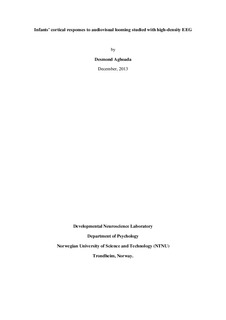| dc.contributor.advisor | van der Meer, Audrey | nb_NO |
| dc.contributor.advisor | van den Weel, Ruud | nb_NO |
| dc.contributor.author | Agboada, Desmond | nb_NO |
| dc.date.accessioned | 2014-12-19T14:22:04Z | |
| dc.date.available | 2014-12-19T14:22:04Z | |
| dc.date.created | 2014-08-06 | nb_NO |
| dc.date.issued | 2013 | nb_NO |
| dc.identifier | 736406 | nb_NO |
| dc.identifier.uri | http://hdl.handle.net/11250/264276 | |
| dc.description.abstract | Infants’ cortical electrical activity as a function of audiovisual looming perception was investigated using high-density electroencephalogram (EEG). Fourteen infants between the ages of 3 and 4 months participated in the study. The aim was to study how audiovisual looming is processed by the infant brain and what timing strategies infants used to time their brain responses to the approaching audiovisual loom. Analysis was performed on all EEG trials in which a looming-related VEP or AEP peak was detected. Results indicated that infants significantly showed earlier looming-related brain responses to the auditory loom than to the visual loom. The results further showed infants used the less sophisticated visual angle/pitch and velocity timing strategies in timing their looming-related brain responses. Using these strategies resulted in errors in judging the loom’s time-to-collision as they are dependent on the approach velocity of the loom. Three infants, however, had developed a more advanced strategy which was based on timing responses to the time-to-collision of the approaching audiovisual loom, but only when timing the collision of the visual loom and not the auditory loom. Furthermore, infants significantly showed looming-related brain responses closer to contact for the faster looms, but no differences in the duration of looming-related VEP and AEP peak responses were detected. When the looming-related peaks at channels Oz (vision) and Cz (audition) were compared, peaks at occipital channel Oz were significantly higher in amplitude for all three loom speeds. In conclusion, it was suggested that audiovisual integration was heavily influenced by infants’ spatial attention captured by the visual loom which resulted in looming-related VEPs that occurred relatively late in the looming sequence. Infants’ response asymmetry was also suggested to represent an evolutionary bias for survival which prioritizes an early auditory response over that of the visual in audiovisual looming perception. The use of less sophisticated timing strategies showed infants’ levels of neural maturity and locomotion experience, two very important factors needed for accurate timing of looming. | nb_NO |
| dc.language | eng | nb_NO |
| dc.publisher | Norges teknisk-naturvitenskapelige universitet, Det medisinske fakultet, Institutt for nevromedisin | nb_NO |
| dc.title | Infants’ cortical responses to audiovisual looming studied with high-density EEG | nb_NO |
| dc.type | Master thesis | nb_NO |
| dc.source.pagenumber | 44 | nb_NO |
| dc.contributor.department | Norges teknisk-naturvitenskapelige universitet, Det medisinske fakultet, Institutt for nevromedisin | nb_NO |


